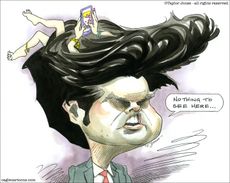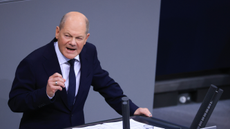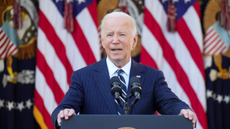Daenerys' cruel isolation, in 19 screenshots
How Game of Thrones' cinematographer David Franco masterfully established Daenerys' loneliness


Remember this?

It has been a long time since we last saw Daenerys surrounded by adoring friends and allies. Game of Thrones' antepenultimate episode, "The Last of the Starks," opened on Sunday with the Breaker of Chains weeping over the body of her oldest and most loyal ally, Jorah, and ended with her watching her next closest friend, Missandei, beheaded. Daenerys even admitted the people of Westeros don't seem to like her: "I saw the way they looked at you," she told Jon Snow. "I know that look. So many people have looked at me that way, but never here." Daenerys could practically be describing the camera itself; since coming to Westeros, she has been progressively isolated, even — and especially — within the frame.



It used to be easy to root for Daenerys due to her likeness to a proto-democratic ruler, with her defining characteristics being an intolerance of oppressive dictators and the love of her subjects. Game of Thrones' sympathetic portrayal, though, has ebbed since she crossed the Narrow Sea to Westeros, where her uncompromising tendencies have increasingly been on display. By this season's fourth episode, Daenerys is even at odds with the people who are supposed to be her allies in the fight against Cersei.
Subscribe to The Week
Escape your echo chamber. Get the facts behind the news, plus analysis from multiple perspectives.

Sign up for The Week's Free Newsletters
From our morning news briefing to a weekly Good News Newsletter, get the best of The Week delivered directly to your inbox.
From our morning news briefing to a weekly Good News Newsletter, get the best of The Week delivered directly to your inbox.
Formally, Thrones has also begun to reflect Daenerys' seclusion. "The Last of the Starks" cinematographer David Franco frequently left Daenerys apart from other characters in his shots, such as during the otherwise crowded feast at the beginning of the episode. While the Starks and their friends bunch together, Daenerys sits several feet apart, as if unable or unwilling to join in. What might have come across as aloofness, though, is tempered by actress Emilia Clarke's expressions, which are often aimed longingly at the people enjoying themselves just out of the frame. Even her toast to Gendry is done alone in the shot. Something, this framing urges us to realize, is off:


(Game of Thrones | HBO)

When Daenerys at last dips away from the celebrations to find Jon, their intimate moment is full of distance, signifying the growing rupture between them. The director chose to show Daenerys enter the room and slowly walk toward Jon, but not quite bridge the space, putting them at one point on opposite sides of the frame. They are joined briefly by an embrace before Jon pulls away and Daenerys is left alone again in a close-up — as much to show the hurt on her face as the fact that she has been rejected.


While the shot/reverse shot technique is a common way to portray a conversation on film — showing first one character speaking, then the other responding over their shoulder — Franco further uses lighting in this scene to make Daenerys look alone even during an intimate discussion. As the couple talks about how they can continue together in their relationship, Jon is so dimly lit in his reverse-shots that it looks almost as if Daenerys is speaking in a room by herself:

A subsequent scene in the Winterfell war room continues to set Daenerys apart from her allies. During the conversation, as Daenerys is at odds with her advisors and the Starks, she is shown frequently in tight shots where Missandei is the only one (and out of focus) behind her. With the death of Jorah at the beginning of the episode, Missandei is now literally and physically the closest person to Daenerys, although even she isn't quite a visual equal:

Compare that to shots of the Starks, who typically stand in the same plane of focus, without one being blurred behind the other (on the occasion that they are in different planes, the camera will switch from shallow to deep focus in order to show them both). Many of the Stark shots are also set up farther away from the characters so the frame appears to be crowded by them, signaling visually the unity of the siblings:


In some of the war room scenes, though, even the blurry image of Missandei vanishes from Daenerys' side, despite the fact that the two had appeared to be standing close together. While many of the protagonists in the war room have brief close-ups, the fact that Daenerys' persist, and that they come while she is actively disagreeing with or threatening her allies, is telling:

The loneliest images of Daenerys, though, come during the showdown with Cersei outside the battlements of King's Landing. Here, close-ups are more traditionally deployed, connecting Daenerys emotionally to Missandei before her execution. This is particularly heartbreaking, though, because of the isolation established by the proceeding hour of television. Missandei wasn't just a close friend; she was literally one of the only people left in Daenerys' shots aside from, on occasion, her advisors. Still, at this point we've heard Tyrion and Lord Varys' treasonous thoughts, and Grey Worm is distracted by the death of his girlfriend. The isolation of Daenerys is complete.


The final shot of the episode, then, is not one of unity or strength, such as a picture of Daenerys, Tyrion, and Grey Worm turning together to regroup for war. It is instead another lone shot of Daenerys, this time with her back turned to her allies, army, and enemy alike, until at last she passes entirely out of the frame.

Despite being the first episode to float the suggestion of Daenerys marrying Jon Snow to solve the problem of succession, the truth is clear: There is no lasting harmony with anyone in Daenerys' future, not if things continue this way. The narrative has done its part to isolate Daenerys from her friends and allies. Now, so cruelly and brilliantly, the camera has done the same.
Sign up for Today's Best Articles in your inbox
A free daily email with the biggest news stories of the day – and the best features from TheWeek.com
Jeva Lange was the executive editor at TheWeek.com. She formerly served as The Week's deputy editor and culture critic. She is also a contributor to Screen Slate, and her writing has appeared in The New York Daily News, The Awl, Vice, and Gothamist, among other publications. Jeva lives in New York City. Follow her on Twitter.
-
 5 contentious cartoons about Matt Gaetz's AG nomination
5 contentious cartoons about Matt Gaetz's AG nominationCartoons Artists take on ethical uncertainty, offensive justice, and more
By The Week US Published
-
 Funeral in Berlin: Scholz pulls the plug on his coalition
Funeral in Berlin: Scholz pulls the plug on his coalitionTalking Point In the midst of Germany's economic crisis, the 'traffic-light' coalition comes to a 'ignoble end'
By The Week UK Published
-
 Joe Biden's legacy: economically strong, politically disastrous
Joe Biden's legacy: economically strong, politically disastrousIn Depth The President boosted industry and employment, but 'Bidenomics' proved ineffective to winning the elections
By The Week UK Published
-
 Walter Isaacson's 'Elon Musk' can 'scarcely contain its subject'
Walter Isaacson's 'Elon Musk' can 'scarcely contain its subject'The latest biography on the elusive tech mogul is causing a stir among critics
By Theara Coleman Published
-
 Welcome to the new TheWeek.com!
Welcome to the new TheWeek.com!The Explainer Please allow us to reintroduce ourselves
By Jeva Lange Published
-
 The Oscars finale was a heartless disaster
The Oscars finale was a heartless disasterThe Explainer A calculated attempt at emotional manipulation goes very wrong
By Jeva Lange Last updated
-
 Most awkward awards show ever?
Most awkward awards show ever?The Explainer The best, worst, and most shocking moments from a chaotic Golden Globes
By Brendan Morrow Published
-
 The possible silver lining to the Warner Bros. deal
The possible silver lining to the Warner Bros. dealThe Explainer Could what's terrible for theaters be good for creators?
By Jeva Lange Last updated
-
 Jeffrey Wright is the new 'narrator voice'
Jeffrey Wright is the new 'narrator voice'The Explainer Move over, Sam Elliott and Morgan Freeman
By Jeva Lange Published
-
 This week's literary events are the biggest award shows of 2020
This week's literary events are the biggest award shows of 2020feature So long, Oscar. Hello, Booker.
By Jeva Lange Published
-
 What She Dies Tomorrow can teach us about our unshakable obsession with mortality
What She Dies Tomorrow can teach us about our unshakable obsession with mortalityThe Explainer This film isn't about the pandemic. But it can help viewers confront their fears about death.
By Jeva Lange Published